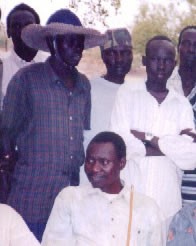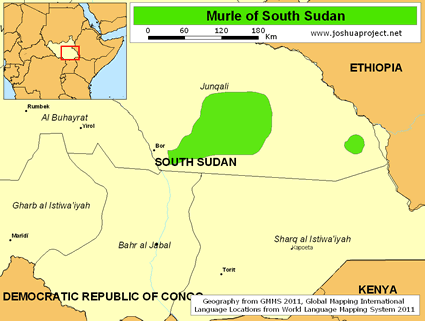Most of the Murle (also called Murele) live in the Pibor district of South Sudan, where they are known as the lowland Murle. They are primarily shepherds. Some of the Murle also live near the Boma Plateau, which lies to the southeast of Pibor. These "highland Murle" make their living as farmers. There are still others who have been drawn westward toward the plentiful watering and grazing grounds provided by the Nile. A small number live in western Ethiopia.
Despite their geographic spread, the Murle remain unified. They speak a common language and maintain close ties. They are a part of the larger people group known as the Surma, who originated in Ethiopia. The Surma gradually moved north, mixing with various peoples along the way. In time, they settled in the place where they live today.
The primary difference between the highland Murle and the lowland Murle is their means of livelihood. The lowland Murle, which makes up the majority, herd cattle and other animals since they consider shepherding the ideal way of life. The highland Murle, however, have either lost their cattle or forsaken shepherding and now live as farmers.
Cattle cannot survive on the Boma Plateau because of the tsetse flies living in the forests of the area. However, the region is very fertile and suitable for agriculture because of its volcanic soil. The plains where the lowland Murle live, on the other hand, are not suitable for agriculture but ideal for herding. Although 90 miles of uninhabited land exists between the lowland and highland Murle, they visit each other frequently, and intermarriage is common and accepted. They feel they need to depend on their fellow Murle during times of war, drought, and economic crisis.
Cattle herding Merle men are expected to give an unreasonable number of cattle for a bride price. The land can only sustain a certain number of cattle. For many years the situation resulted in cattle rustling.
The home is the center of the Murle way of life. Their settlements are made of a series of huts arranged into a circle. The huts are linked together by thorn hedges, which keep the cattle inside and protect them from harm. The highland Murle also have gardens near their huts.
Women usually build the huts. They are beehive-shaped and are made of thatched bundles of grass. The center of social activity for a settlement is "the club," a large shady tree where the elders sit, smoke, and discuss village matters. There is also a dancing floor beside this tree.
Children receive practical education from their parents at a very early age. A boy is taught to respect his elders, to be polite, not to insult, and to always be honest. By the time a girl is in her early teens, she is good-natured, a hard worker and a good cook.
The Murle are animists (believe that non-living objects have spirits), following the ethnic and religious practices of their ancestors. They believe the earth is flat and that their home in South Sudan is at the center. The word for "sky" and the word for "God" are the same: Tammu. They believe that Tammu created the universe and that rain is a gift from him. They also believe that Tammu is everywhere, all-knowing, the supreme judge and ruler, and greater than all things.
Unfortunately, the Murle also believe some spirits dwell in animals and that the spirits of their ancestors are still present. The Murle regularly solicit the help of healers and diviners, who they believe can ward off evil spirits and curses. They believe visits to these diviners can keep the good spirits on their side, as well as keep evil spirits away from them.
Because of the work of Presbyterian missionaries in Ethiopia, the number of devoted Christians among the Murle people is much higher in Ethiopia than in South Sudan. Christianity has been a force to attempt to bring peace in both countries.
More than anything, the Murle need prayer, so that the Holy Spirit will plant within their hearts a desire to know the one true God. They have the New Testament in their language. Perhaps the Murle's belief in a supreme god will provide a starting point for missionaries to share the gospel with them.
Ask the Lord of the harvest to send forth laborers into South Sudan to disciple the Murle people.
Ask God to speed the completion of additional evangelistic materials into the Murle language.
Ask the Lord to establish Murle churches that will plant more churches.
Pray for a just and lasting peace in South Sudan.
Scripture Prayers for the Murle in South Sudan.
https://en.wikipedia.org/wiki/Murle_people
https://minorityrights.org/communities/murle/
https://www.tandfonline.com/doi/full/10.1080/17531055.2023.2259547
https://www.murleheritage.com/
https://www.101lasttribes.com/tribes/murle.html
https://www.cmi.no/file/1964-Murle.pdf
| Profile Source: Joshua Project |












